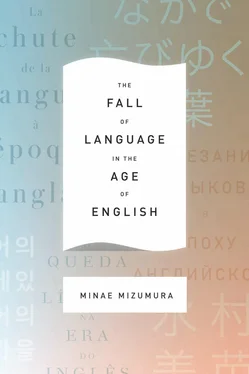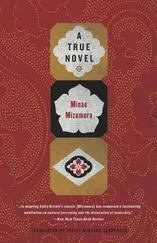The leftist intellectuals, the Occupation forces, and the Ministry of Education agreed on one thing: that written Japanese should espouse phoneticism. The intellectuals’ equation of egalitarianism and antielitism led them to believe that all Japanese people were potentially not just readers of books but writers, and only the difficulty of the language stood in their way. Anyone who is born and grows up in Japan can speak the language, they reasoned; therefore, if the written language were made easier to reflect the spoken language more closely, then everyone, no matter how far removed from books his or her daily life might be, could write — the rice farmer and the factory worker no less than the literary lion. In their idealism, these leftists wound up sharing the same goal, in principle, as the occupying forces, who, taken aback by the mysteries of the incomprehensible signs all around them, were calling for the complete romanization of the Japanese writing system. They thus also wound up sharing the same goal as the Ministry of Education, which, from its inception in Meiji, was a citadel of phoneticism.
The United States Education Mission to Japan arrived in March 1946, seven months after the end of the war. The mission, which played a decisive role in reforming Japan’s public education system, ended its brief stay with a declaration confirming the opinion of the general headquarters (GHQ) of the American Occupation forces that the best thing to do with the Japanese language would be to romanize it. It was as if the Ministry of Education had heard a resounding voice from above, confirming the legitimacy of its cherished belief in phoneticism. As a step in simplifying and modernizing the Japanese language, at the end of that year, just over a year after the country’s surrender, the ministry unilaterally enforced three language “reforms” through compulsory education and the mass media: the number of Chinese characters to be used was restricted, the form of many characters was simplified, and the traditional kana orthography was altered to reflect pronunciation more accurately.
When print language is established, it is only natural that the written language should somehow regulate itself to meet the demands of the market. Governmental intervention may also come into play, depending on circumstances. In Japan, it made sense to put limits on the number of Chinese characters used in official documents and media and to simplify the most frequently used ones in some logical way. Likewise, it made sense to alter the use of kana to fit the modern language. But spurred by the declaration of the GHQ and the United States Education Mission, the Japanese Ministry of Education acted with inappropriate haste and unforgivable cavalierness, implementing drastic change before anyone realized what was happening. Out of a pool of tens of thousands of Chinese characters, the ministry limited the number for everyday use to 1,850—without consulting experts, let alone seeking public opinion. (The number may still seem huge, but the reader should bear in mind that learning Chinese characters is akin to learning vocabulary.) Further, those characters were simplified in a haphazard way, taking out a line here and a dot there, as if it didn’t matter that omitting a single stroke can sever a character from its semantic roots. Perhaps most damaging was the switchover to phonetic kana, which obscured the roots of a wide array of words. In English it would be almost as bad as enforcing a new spelling of philosophy as “filosofee.”
Then, in August 1948, to establish how detrimental the use of Chinese characters was to Japanese literacy, a nationwide survey was conducted under the orders of John Pelzel, an officer in the Civil Information and Educational Section of the GHQ. The survey was extensive, testing a random sampling of 16,814 men and women ages fifteen to sixty-four. Given its long-standing espousal of phoneticism — the first minister of education was Mori Arinori, who had recommended adopting English as the national language — the Ministry of Education would likely have had no objection to implementing romanization if the GHQ had insisted, however impractical and ultimately impossible that course might have been. But unexpectedly, the results demonstrated no such need: a mere 2.1 percent of those tested proved to be functionally illiterate.
Pelzel apparently found this outcome hard to accept. One day, he summoned to his hotel room a budding linguist named Shibata Takeshi, who had helped conduct the survey, and asked him point-blank to rewrite the results. Though a strong lifelong supporter of romanization, Shibata refused on the grounds that “as a scholar” he could not do such a thing. Pelzel did not force the issue. And so, with this brief conference in a hotel room, where two men talked sitting on a bed side by side, the country was spared the fate of adopting romanization — at least for the time being. 3
The survey results did not halt the movement to switch to the Roman alphabet. Romanization remained an ultimate goal of the Occupation’s GHQ and a goal considered well worth pursuing by the Ministry of Education, which had direct control over Japan’s language policies. And since the Ministry of Education was solidly in favor of phoneticism, the movement continued to gain steam even after the departure of the U.S. forces. A new National Language Research Council was established to explore the merits of such a change, and school curriculums were redesigned to increase the number of school hours devoted to writing Japanese in rōmaji , Roman letters. On top of all this, the emergence of the typewriter, ubiquitous in American films and television dramas as a symbol of modern times, added urgency to the debate: those in favor of romanization threatened that unless the Japanese abolished Chinese characters forthwith, they would be left behind in the dust, unable to use that epitome of modern civilization. The debate over how to do this went on for years; as at the dawn of Japan’s modern era, not only those in favor of romanization but proponents of various phonetic writing styles (hiragana, katakana, or some brand-new form of writing yet to be invented) all strenuously made their case.
“REACTIONARY” INTELLECTUALS
In retrospect, it seems almost bizarre that the hastily implemented changes and ongoing push toward romanization aroused no opposition at the time. But those who were aware of what was happening to the Japanese language — the media that had to use new printing and the schoolteachers who had to teach a new way of writing, not to mention the editors involved in drawing up new textbooks — consisted of virtually all those who had swung left after the war. People who might have had qualms voiced no protest, perhaps because they dared not. Most disturbing in the face of such governmental control over the language was the silence of public intellectuals — the nation’s “spiritual guides,” those who could have spoken out and been heard. As writers themselves, not all of them could have been insensitive to the government’s tampering with the written language as they knew it. Behind their silence lay the unpleasant historical fact that the Japanese Empire left muddy footprints in Asia, including forcing the Japanese language on its colonies in Taiwan and Korea — something we shall come back to later.
The first public intellectual to speak up against phoneticism was Fukuda Tsuneari (1912–1994), a scholar of English literature and respected translator of Shakespeare whose name came to be preceded with the derogatory label “reactionary.” In 1958, more than ten years after the changes had been implemented, Fukuda began publishing a series of journal articles that informed the Japanese reading public for the first time of the offhand manner in which the Japanese language had been tampered with. Then in 1961, several writers who had participated in the National Language Research Council quit, declaring publicly that the council was stacked in favor of phoneticism and there was no point in continuing the debate. This made headlines. The following year, the committee on romanization was disbanded. And in 1966, the head of the council, Education Minister Nakamura Umekichi, held a news conference laying out for the first time in Japan’s modern history an official policy on what the written language should be: a mixture of Chinese characters and Japanese kana. This declaration must have come as a surprise to the general public, most of whom were unaware that these debates were going on and never dreamed that their language could be written otherwise. And so — exactly one hundred years after Maejima Hisoka’s petition to the shogun to eradicate Chinese characters — the issue was finally laid to rest.
Читать дальше












